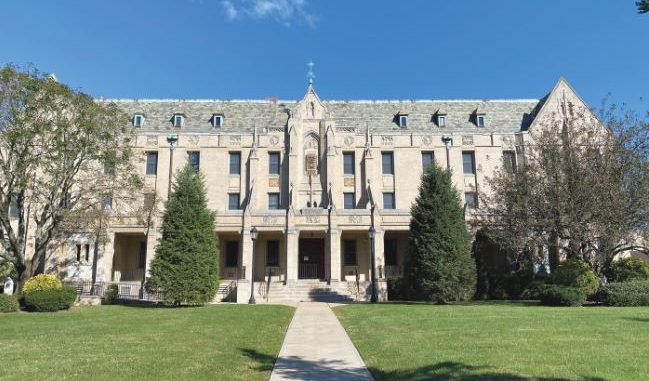
The administration building for
the Diocese of Rockville Centre,
1 Quealy Pl., Rockville Centre.
(Photo by Marco Schaden)
A $323 million settlement was made official Wednesday between hundreds of sexual abuse survivors and the Diocese of Rockville Centre – which encompasses 132 local parishes across Long Island – after a four-year case of allegations spanning decades.
“Feelings of anger over the abuse scandal and its ongoing effects are justified and understandable,” Rev. Eric Fasano wrote in an email. “We may not have caused this scandal, but we have all suffered its effects.”
The Diocese of Rockville Centre said in a statement that it is thankful to god for the settlement and hopes it will bring “some measure of healing to survivors.”
“Victim survivors of child abuse deserve our respect, our prayers, and our pastoral support,” the diocese wrote. “The Church is grateful for their courage and perseverance.”
Fasano said parishioners have overwhelmingly supported the compensation for survivors and “allowing the Church to get on with our mission, free from the liabilities of the past.”
He said the diocese, local parishes, insurance companies and other related entities will pay the entire settlement.
The diocese, its parishes and other related entities will contribute $234.8 million to the settlement. Insurance companies will contribute about $85 million and $3 million from the Counsel for the Creditor’s Committee.
The amount each individual parish contributes varies. It is determined by the parish’s “available unrestricted resources” and the number of cases brought against the church, Fasano said.
Newsday reported that parishes’ individual contributions vary, from Southold’s St. Patrick contributing $82,553 to St. Mary’s in Manhasset, which will pay nearly $4.5 million.
Fasano said the parishes’ individual contributions are to protect them from potential historical lawsuits.
“All participated in order to offer equitable compensation to survivors and move this difficult ordeal towards its conclusion,” Fasano wrote.
Funds for the settlement are not coming from parishioners nor Catholic Ministries Appeal donations, Fasano said, but rather through cash reserves, investments and rental income.
The bankruptcy case will not result in any parishes closing.
“Parishes will now continue their ministry, free from historical lawsuits and free from bankruptcy,” Fasano wrote in an email to Schneps Media Long Island.
The four-year case concerned reports of sexual abuse by the diocese’s clergy from more than 600 victims, with some reports dating back as far as 1957 when the diocese first opened. Cases concerned various churches throughout the diocese’s 132-parish network.
“The majority of our clients are in their 60’s and 70’s – they have been waiting decades for justice, and we are extremely pleased to reach this settlement on their behalf,” said Adam Slater in a September statement, founding and managing Partner of Slater Slater Schulman LLP, which represents about 100 of the 600 clients in the case. “Importantly, this is the largest Diocese settlement in the history of New York State.”
The lawsuits were made possible by the 2019 Child Victims Act, which extended the statute of limitations for victims and opened a temporary “look back” window where people of any age could file lawsuits to seek justice for abuse they had experienced as children.
The Diocese of Rockville Centre attempted to overturn this act but failed.
The diocese filed for bankruptcy in 2020 after more than 200 lawsuits were filed on behalf of the victims the prior year.
The church had previously suggested a $200 million settlement to dismiss the bankruptcy case in April, while survivors requested $450 million.
Wednesday’s confirmed settlement, which had been finalized in September, met in the middle.
“The Diocese’s goal has always been the equitable compensation of survivors of abuse while allowing the Church to continue her essential mission,” the diocese wrote in a statement. “We believe this plan has achieved those goals.”

